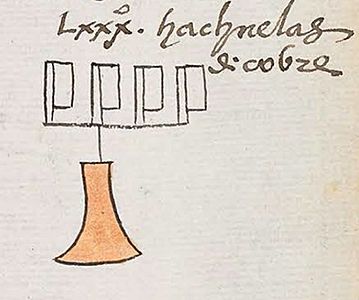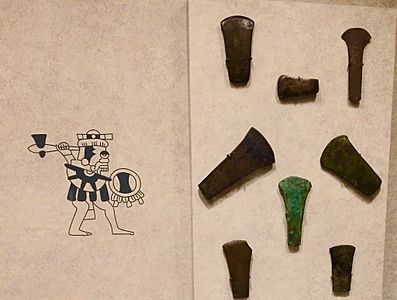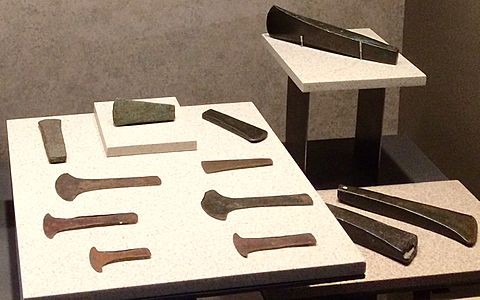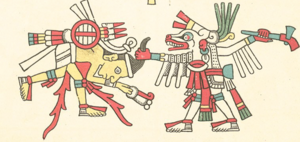Tlaximaltepoztli facts for kids
Quick facts for kids Tepoztli |
|
|---|---|
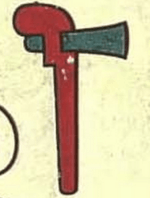
Bronze axe from Mexica culture in the Codex Laud
|
|
| Type | Axe |
| Place of origin | Mexico |
| Service history | |
| In service | Pre-classic to Post-Classic period (900–1570) |
| Used by | Aztecs, Mayans, Purépecha, Mixtecs |
| Wars | Spanish conquest of the Aztec Empire, Aztec expansionism, Mesoamerican Wars |
| Specifications | |
| Mass | 1.5–3.0 kg |
| Length | 30-45 cm |
|
|
|
| Blade type | Curved, thick, single-edged, tapered |
| Hilt type | Single-handed swept |
| Scabbard/sheath | unknown |
| Head type | Trapezoidal |
| Haft type | Straight or Curved, of a single metallic piece or wooden |
The tepoztli (pronounced teh-POHZ-tlee) was an important axe used by ancient civilizations in Mesoamerica. Its full name in Nahuatl is tlaximaltepoztli, which means "carpentry metal axe." This axe had a bronze head attached to a wooden handle.
People used the tepoztli for two main things: as a weapon in battles and as a tool for everyday tasks. Ancient books like the Codex Mendoza and the Codex Fejérváry-Mayer show how it was used. The Aztec Empire even made conquered kingdoms pay tribute with these axes. In Aztec mythology, the god Tepoztécatl, who was linked to drinks and good harvests, was often shown holding a bronze axe.
Contents
What Was the Tepotzli Like?
The tepoztli was a special weapon for many kingdoms in Mesoamerica. It was used during the Spanish conquest of the Aztec Empire in the 1500s. The Purépecha Empire was especially known for using these axes, and many original tepoztli pieces have been found from their time.
These axes were usually about 38 to 90 centimeters (15 to 35 inches) long. The bronze axe head had a hole where the wooden handle was inserted. A strong natural glue, made from pine tree sap and coal, held the head firmly in place.
Some decorative versions of the tepoztli were called axe-monies. These were highly valued, but they were not very good for fighting. They were too thin and could break easily.
Besides being a weapon, the tepoztli was also a common tool. People used it to make wooden objects. It was a regular item in Aztec homes. In Tenochtitlan, the Aztec capital, the axe was even part of a wedding gift for common people. It was given to the wife along with other household items.
- Mesoamerican Bronze Axes
How Were Tepotzli Axes Made?
Most Mesoamerican axes from the later Post-classic period were made of bronze. Bronze is a strong metal, and these axes were very hard. Older axes from the Pre-classic period were made of copper, which was not as hard.
The knowledge of how to work with metals came to West Mexico by sea. Traders brought this technology from places as far south as Ecuador. Objects found in Ecuador and West Mexico are very similar. They have the same chemical makeup and were made using the same techniques. This shows that people traded ideas and goods across long distances.
The metal in the axe head was not equally hard everywhere. The edges were made much harder by hammering them when the metal was cold. This made the cutting edge strong. The rest of the axe was left a bit softer so it could handle the impacts of daily use without breaking.
Where Did the Tepotzli Come From?
The tlaximaltepoztli was used across many parts of Mesoamerica. Different cultures were skilled at working with metals. They also used bronze to make tools for creating stone sculptures and gravestones.
Many copper mines were found near the Purépecha state, in what is now the Mexican state of Michoacán. The Spanish also used these mines later. Bronze axes were also used by the Inca Empire and other civilizations in South America. They used these axes as weapons to control local kingdoms or to defend against invaders.
Tepotzli in Stories
The bronze axe is mentioned in an old story called the Relación de Michoacán. This story tells about Princess Eréndira of the Purépecha people. She bravely fought against the Spanish invasion. In one part of the story, local women dress the princess and give her axes to cut firewood. This was part of the preparations for her wedding.
The Relación de Michoacán also mentions another interesting custom. If a man remarried, he had to spend four days gathering wood before the wedding. This was a kind of penance or a way to show he was sorry for something.
See also
 In Spanish: Tlaximaltepoztli para niños
In Spanish: Tlaximaltepoztli para niños


